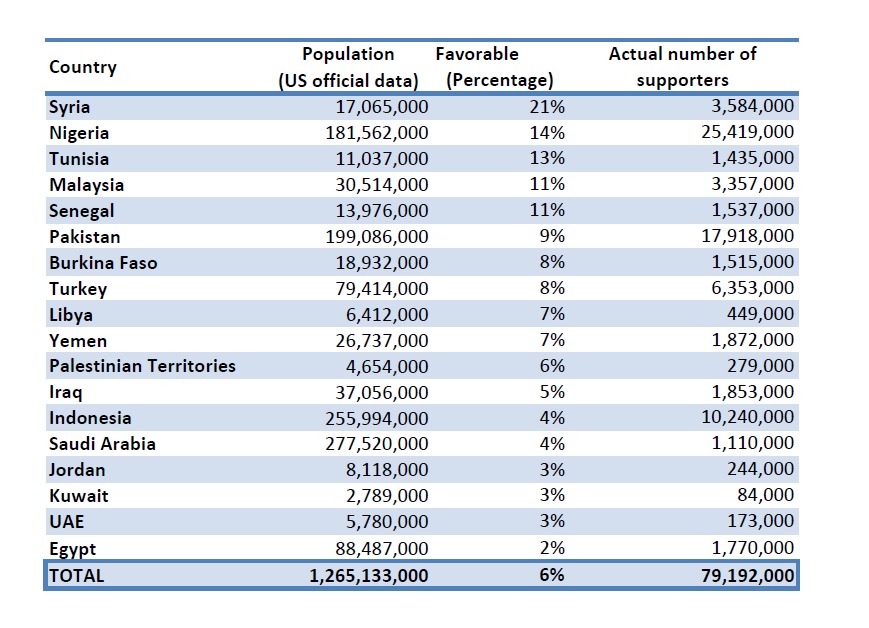ISIS may not be winning the popularity contest, but…
This article is by ASP Adjunct Fellow Pascale Siegel.
As pollsters would have it, there is much disdain for ISIS (hereinafter Daesh) across the Muslim World. According to the Pew Research Center, “people from Nigeria to Jordan or Indonesia overwhelmingly expressed negative views” of Daesh. Meanwhile, the Washington Institute for Near East Studies concluded from its own polling that Daesh “has already lost the war of ideas” and that “the Paris terrorist attacks feed a false narrative that [Daesh] has somehow attracted a mass following among Arabs.” An average of major reputable polls compiled by the British firm Statista indicates that outside of Syria, the favorability rating for Daesh never tops 15%.
 These are positive results only if we think in terms of electoral politics. Indeed, there is not an electoral regime under which such low approval ratings can propel an organization into power. In electoral politics, one needs a majority and/or a plurality (depending on the particulars of the electoral system) to cross the finish line. In most practical cases, 15% does not amount to a governing plurality.
These are positive results only if we think in terms of electoral politics. Indeed, there is not an electoral regime under which such low approval ratings can propel an organization into power. In electoral politics, one needs a majority and/or a plurality (depending on the particulars of the electoral system) to cross the finish line. In most practical cases, 15% does not amount to a governing plurality.
However, Daesh is not vying for power in an electoral contest. It is engaged in a multi-prong war to establish and defend its territorial control over Sunni lands in the heart of the Middle East. That territory, a Sunnistan of sort, where Sunnis would live and govern themselves, would then serve as the backbone of a so-called Caliphate destined to expand to all Muslim lands.
It is within this framework, not in the context of electoral politics, that Daesh “low” popularity must be analyzed. And under these circumstances, the support numbers show that Daesh has at its disposal a very significant pool of supporters across the Muslim world from which it can recruit operatives to support its plans.
The table below translates the percentage of support (chart above) into the actual numbers of supporters.
This is not to say that all those who view Daesh favorably will necessarily turn around to become supporters or active members of the group and its offshoots around the world. Declarations of support in favorability ratings are notoriously difficult to interpret. They may reflect actual support for the group and/or opposition to competing authorities such as the regimes in place. Syria and Nigeria where Daesh is in open conflict with the authorities are also the countries with the larger support. The strength of that support may reflect both the appeal of Daesh and defiance and opposition to the regimes.
Moreover, even a few percentage points of 1.5 billion Muslims around the world still represent a large number of people as attested by the figures above. It amounts to a pond full of people that Daesh can target for recruitment either for emigration to the so-called “Islamic State” or for action where they are located.
Lastly, over the last year and a half, Daesh has proven that it does not take many determined supporters to launch and sustain a global terrorist campaign. Between the declaration of the so-called Caliphate in June 2014 and the end of January 2016, Daesh carried out 61 attacks worldwide. Based on media reporting of these attacks, they killed at least 1,172 people and wounded at least 2,227. (These figures are drawn from international news reporting from professional sources (CNN, BBC, Le Monde, Al-Jazeera) immediately following each attack. Authorities may have adjusted these figures in the aftermath.) Data on perpetrators are difficult to compile, as they are generally not the focus of initial media reporting. In 53% of the attacks perpetrated over the past year and a half, media reporting makes no mention of the perpetrators; how many or who they were. In the remaining 47%, the number of perpetrators varied from 1 to 9. Admittedly, perpetrators are likely supported by a larger logistical cell that provides money, weapons, ammunition, food, lodging, and possibly direction. Even if the logistical footprint is three or four time larger than that left by the perpetrators, the data shows that a few motivated people can cause grave disruptions.






